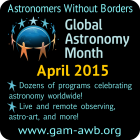 MOUNTAIN VIEW – On July 14, NASA’s New Horizons spacecraft will fly past Pluto, offering the first close-up look at that small, distant world and its largest moon, Charon. These denizens of the outer solar system will be transformed from poorly seen, hazy bodies to tangible worlds with distinct features.
MOUNTAIN VIEW – On July 14, NASA’s New Horizons spacecraft will fly past Pluto, offering the first close-up look at that small, distant world and its largest moon, Charon. These denizens of the outer solar system will be transformed from poorly seen, hazy bodies to tangible worlds with distinct features.
Now, the public can help decide what labels will go on the images and maps coming from the flyby. The SETI Institute has announced the launch of its “Our Pluto” campaign, which is soliciting input on how to name features on the surfaces of Pluto and Charon.
“Pluto belongs to everyone,” says New Horizon science team member Mark Showalter, a senior research scientist at the SETI Institute. “So we want everyone to be involved in making the map of this distant world.”
The science team will not have time to come up with names during the quick flyby, so they must assemble a library of names in advance. Consequently, they are inviting the public to visit the web site http://ourpluto.seti.org where they can vote for the names they think should be used to identify the most prominent features on both Pluto and Charon. They can also suggest additional names. These must be associated with a set of broad themes related to mythology and the literature and history of exploration.
After the campaign ends on April 7, the New Horizons team will sort through the names and submit their recommendations to the International Astronomical Union (IAU). The IAU will decide how the names are used.
Currently, the best images of Pluto from the Hubble Space Telescope provide just a hint of what might be in store for the New Horizons cameras. It shows a world marked by sharp contrasts, with some areas as dark as asphalt and others as bright as snow.
“The Pluto flyby this summer will be a major milestone in planetary exploration,” said Alan Stern, Principal Investigator of the New Horizons project. “We are really looking forward to hearing the public’s ideas for feature naming on Pluto and Charon.”
Showalter led the teams that used the Hubble Space Telescope to discover the two smallest known moons of Pluto, Kerberos and Styx. Those satellites were also named via a public campaign.
“The difference is that last time we only needed two names, whereas now we could need more than a hundred,” Showalter notes. “We are eager to gather recommendations from people all over the world.” The web site also includes an extremely simple ballot to allow young children to participate.
More information about the New Horizons mission:
http://www.nasa.gov/newhorizons
Continue reading
 Global Astronomy Month (GAM), organized each April by Astronomers Without Borders, is the world’s largest global celebration of astronomy. GAM 2015 brings new ideas and new opportunities, again bringing enthusiasts together worldwide to celebrate Astronomers Without Borders’ motto “One People, One Sky.” See more at: http://astronomerswithoutborders.org/
Global Astronomy Month (GAM), organized each April by Astronomers Without Borders, is the world’s largest global celebration of astronomy. GAM 2015 brings new ideas and new opportunities, again bringing enthusiasts together worldwide to celebrate Astronomers Without Borders’ motto “One People, One Sky.” See more at: http://astronomerswithoutborders.org/




 MOUNTAIN VIEW – On July 14, NASA’s New Horizons spacecraft will fly past Pluto, offering the first close-up look at that small, distant world and its largest moon, Charon. These denizens of the outer solar system will be transformed from poorly seen, hazy bodies to tangible worlds with distinct features.
MOUNTAIN VIEW – On July 14, NASA’s New Horizons spacecraft will fly past Pluto, offering the first close-up look at that small, distant world and its largest moon, Charon. These denizens of the outer solar system will be transformed from poorly seen, hazy bodies to tangible worlds with distinct features.